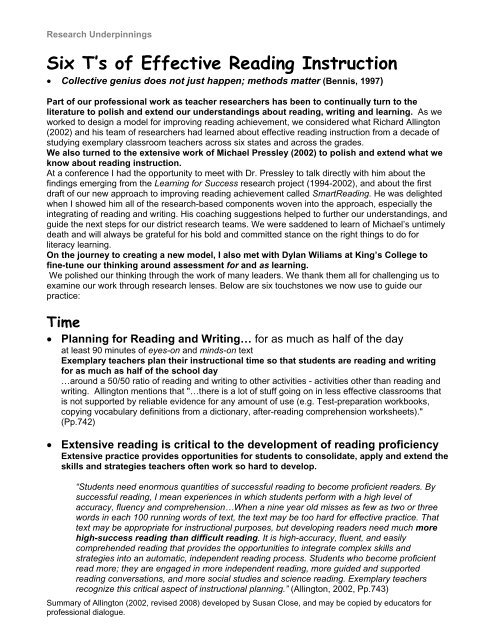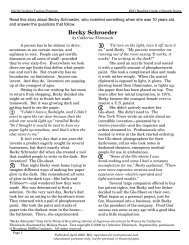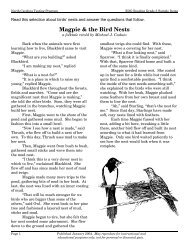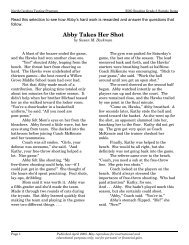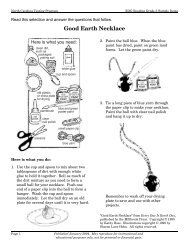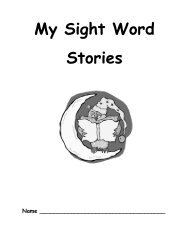Six T’s of Effective Reading Instruction
Six T's of Effective Reading Instruction
Six T's of Effective Reading Instruction
You also want an ePaper? Increase the reach of your titles
YUMPU automatically turns print PDFs into web optimized ePapers that Google loves.
Research Underpinnings<strong>Six</strong> <strong>T’s</strong> <strong>of</strong> <strong>Effective</strong> <strong>Reading</strong> <strong>Instruction</strong>• Collective genius does not just happen; methods matter (Bennis, 1997)Part <strong>of</strong> our pr<strong>of</strong>essional work as teacher researchers has been to continually turn to theliterature to polish and extend our understandings about reading, writing and learning. As weworked to design a model for improving reading achievement, we considered what Richard Allington(2002) and his team <strong>of</strong> researchers had learned about effective reading instruction from a decade <strong>of</strong>studying exemplary classroom teachers across six states and across the grades.We also turned to the extensive work <strong>of</strong> Michael Pressley (2002) to polish and extend what weknow about reading instruction.At a conference I had the opportunity to meet with Dr. Pressley to talk directly with him about thefindings emerging from the Learning for Success research project (1994-2002), and about the firstdraft <strong>of</strong> our new approach to improving reading achievement called Smart<strong>Reading</strong>. He was delightedwhen I showed him all <strong>of</strong> the research-based components woven into the approach, especially theintegrating <strong>of</strong> reading and writing. His coaching suggestions helped to further our understandings, andguide the next steps for our district research teams. We were saddened to learn <strong>of</strong> Michael’s untimelydeath and will always be grateful for his bold and committed stance on the right things to do forliteracy learning.On the journey to creating a new model, I also met with Dylan Wiliams at King’s College t<strong>of</strong>ine-tune our thinking around assessment for and as learning.We polished our thinking through the work <strong>of</strong> many leaders. We thank them all for challenging us toexamine our work through research lenses. Below are six touchstones we now use to guide ourpractice:Time• Planning for <strong>Reading</strong> and Writing… for as much as half <strong>of</strong> the dayat least 90 minutes <strong>of</strong> eyes-on and minds-on textExemplary teachers plan their instructional time so that students are reading and writingfor as much as half <strong>of</strong> the school day…around a 50/50 ratio <strong>of</strong> reading and writing to other activities - activities other than reading andwriting. Allington mentions that "…there is a lot <strong>of</strong> stuff going on in less effective classrooms thatis not supported by reliable evidence for any amount <strong>of</strong> use (e.g. Test-preparation workbooks,copying vocabulary definitions from a dictionary, after-reading comprehension worksheets)."(Pp.742)• Extensive reading is critical to the development <strong>of</strong> reading pr<strong>of</strong>iciencyExtensive practice provides opportunities for students to consolidate, apply and extend theskills and strategies teachers <strong>of</strong>ten work so hard to develop.“Students need enormous quantities <strong>of</strong> successful reading to become pr<strong>of</strong>icient readers. Bysuccessful reading, I mean experiences in which students perform with a high level <strong>of</strong>accuracy, fluency and comprehension…When a nine year old misses as few as two or threewords in each 100 running words <strong>of</strong> text, the text may be too hard for effective practice. Thattext may be appropriate for instructional purposes, but developing readers need much morehigh-success reading than difficult reading. It is high-accuracy, fluent, and easilycomprehended reading that provides the opportunities to integrate complex skills andstrategies into an automatic, independent reading process. Students who become pr<strong>of</strong>icientread more; they are engaged in more independent reading, more guided and supportedreading conversations, and more social studies and science reading. Exemplary teachersrecognize this critical aspect <strong>of</strong> instructional planning.” (Allington, 2002, Pp.743)Summary <strong>of</strong> Allington (2002, revised 2008) developed by Susan Close, and may be copied by educators forpr<strong>of</strong>essional dialogue.
Research UnderpinningsTexts• "Smart" organizations…support teachers by providing a rich andexpansive supply <strong>of</strong> texts to promote children’s learning across the schoolday, rich supply <strong>of</strong> books they can actually readThe texts are chosen to promote learning across the day and across the curriculum. The choicesincluded multi-level texts for social studies and science as well as for reading in the language arts.Organizations that know that one-size-fits-all contradicts everything we have learned abouteffective teaching.The exemplary teachers noticed that high-achieving students:1. Received a steady diet <strong>of</strong> "easy" texts - texts they could read accurately, fluently, and withgood comprehension.2. Consistently out-gained both average-achieving and lower-achieving students year after year.They also noticed that motivation for reading was dramatically influenced by readingsuccess.They acted on those observations by creating multi-level, multi-sourced curricula that met theneeds <strong>of</strong> the diverse range <strong>of</strong> students in their classrooms.Teaching• Explicit demonstrations <strong>of</strong> cognitive strategies good readers useStudents <strong>of</strong> all achievement levels benefited from exemplary teaching, but it is the lowestachievers who benefited most (Allington and Johnson, 2002; Pressley, 2002).In some classrooms, some low achieving students spend 80% <strong>of</strong> their instructional time in textsthat are inappropriately difficult to make much progress academically. Some low achievingstudents receive appropriate reading materials only when they participate in special supportinstruction (resource support).In exemplary classrooms low achieving students spend their day with books they cansuccessfully read. Exemplary teachers…use active instruction – modelling anddemonstrating strategies skilled readers use as they read.They model the thinking in ‘think-alouds’ that skilled readers engage in as they attempt to decodea word, self-monitor for understanding, construct pictures in their minds, summarize and questionwhile reading or editing when composing. They adopt a watch me’ or ‘let me demonstrate’ stance.These teachers "…routinely give direct, explicit demonstrations <strong>of</strong> the cognitive strategiesgood readers engage in as they read…The "watch me" or "let me demonstrate" stance seems quite different from the "assign andassess" stance that dominates many less effective classrooms…Summary <strong>of</strong> Allington (2002, revised 2008) developed by Susan Close, and may be copied by educators forpr<strong>of</strong>essional dialogue.
Research UnderpinningsMuch <strong>of</strong> what teachers consider teaching is little more than assignment and assessment…theassign and assess model has little benefit to all but a few students who have already acquired abasic understanding <strong>of</strong> the strategy. (Pp.743)In a traditional phonics program, when teachers assign a worksheet that requires children to fill inthe missing vowel, only children who already know the corresponding response can successfullydo the task. And they don’t need the practice. When assigned a story to read and questions toanswer at the end, children who have developed the appropriate strategy to use while reading canrespond appropriately, but those who have not developed it cannot.They cannot acquire the strategy from the end-<strong>of</strong>-the-story questions. They need someoneto teach it to them – someone who can model and demonstrate its use.Linguistic communication is the primary vehicle for human thinking and learning (Vygotsky).What makes the human mind so powerful is the use <strong>of</strong> speech for learning and inparticular an elaborated syntax linked to a powerful symbolic memory which enableshumans to elaborate, refine, connect, create and remember great numbers <strong>of</strong>concepts…one <strong>of</strong> our key aims is to develop linguistic intelligence through enhancingin students their powers <strong>of</strong> communication and concept formation.The more we can encourage children to think about thinking, the more we can help them gainmetacognitive awareness and understanding <strong>of</strong> their own minds. Conscious reflective controland deliberated mastery are essential factors in school learning.Learning depends on conversations, on the negotiation <strong>of</strong> personal meanings throughdialogue with others, leading to improved understanding. These conversations can beinternal, but are particularly effective carried out in pairs, or in groups, where differentways <strong>of</strong> interpreting experience can be explored to mutual benefit.Exemplary teachers realized that instructional packages <strong>of</strong>ten provide little comprehensive oruseful information on the direct and explicit teaching <strong>of</strong> comprehension skills or cognitivestrategies…they craft explicit demonstrations <strong>of</strong> the skills and strategies:E.g. The deletion strategy, when teaching summarization, was modelled as a ‘watchme-do-this.’Teachers would demonstrate through a ‘think-aloud’ process how to deleteredundant, trivial, and subordinate information until they arrived at a summarystatement.They demonstrated strategies to the whole class, to targeted small groups, and toindividual students in side-by-side instruction. …The plethora <strong>of</strong> instructional activitiestruly set these teachers apart, and explains much <strong>of</strong> their success with lower-achievingstudents. (Pp. 744)Expert teaching requires knowing not only how to teach strategies explicitly, but alsohow to foster transfer <strong>of</strong> the strategies from the structured practice activities tostudents' independent use <strong>of</strong> them while engaged in reading (Pp. 744).A real concern is that when instruction becomes too explicit, children never learn when andhow to use the strategies pr<strong>of</strong>itably and successfully in their independent reading.How will we know if the students are transferring the skills to independent use whilethey are reading? Regular structured assessment conversations are one way to accessthe information. Smart<strong>Reading</strong> <strong>of</strong>fers teachers regular structured time to conduct bothformal and informal assessment conversations.Summary <strong>of</strong> Allington (2002, revised 2008) developed by Susan Close, and may be copied by educators forpr<strong>of</strong>essional dialogue.
Research Underpinnings<strong>Effective</strong> learning is not just the manipulation <strong>of</strong> information so that it is integrated intoan existing knowledge base, but also involves directing one’s attention to what hasbeen assimilated, understanding the relationship between the new information andwhat is already known, understanding the processes which facilitated this, and beingaware when something new has actually been learned.It involves not only thinking but also a metacognitive process: thinking about thinking. Flavelargues that metacognitive ability changes with age, and older children simply become moresuccessful learners because they have internalized over time a great quantity <strong>of</strong> metacognitiveinformation.Metacognitive development is not so much dependent on age but on experience, andwe can intervene to help even young children to develop some <strong>of</strong> the metacognitivestrategies <strong>of</strong> successful learning.Like compound interest, metacognitive strategies can be said to increase learners’ intellectualcapacity. Such strategies, valuable as they are, do not go far enough.Learning depends on conversations, on the negotiation <strong>of</strong> personal meanings throughdialogue with others, leading to improved understanding.These conversations can be internal, but are particularly effective carried out in pairs, orgroups, where different ways <strong>of</strong> interpreting experience can be explored to mutual benefit.Co-Teaching adds a new bold-T to effective learning.As our research teams have engaged in the new learning round model – where they plan, coteach,reflect, analyze, assess and plan-anew – together, a new T has been set into our way <strong>of</strong>working. One <strong>of</strong> the leaders reflects:“As teachers participate in learning rounds and co-plan lessons, critical dialogue occursaround how to best support learning at each <strong>of</strong> the stages. Through these conversations,tools are selected to ‘best-fit’ the development <strong>of</strong> targeted skills. Powerful conversations aboutmatching tools with desired outcomes push everyone’s thinking, learning and pr<strong>of</strong>essionalpractice.”Talk• Exemplary teachers fostered much more student talk: teacher - student,and student - student talkExemplary teachers encouraged, modeled and supported purposeful talk across the schoolday.The talk was problem posing, problem-solving talk related to curricular topics. Teachers andstudents discussed ideas, concepts, hypotheses, strategies, and responses with one another.Teachers posed more "open" questions, to which multiple responses were appropriate.' (Pp.745)Open questions <strong>of</strong>fer the opportunity to examine thinking, the strategy as it is being used and tocontinue instruction. Open questions assess a broader understanding and help make children’sthinking visible:“So, what other story have we read that had an ending like this one?”“Has anyone known <strong>of</strong> a problem with a pet like the one in the story?”Summary <strong>of</strong> Allington (2002, revised 2008) developed by Susan Close, and may be copied by educators forpr<strong>of</strong>essional dialogue.
Research UnderpinningsThe interrogational nature <strong>of</strong> most classrooms talk…where teachers pose the questions andchildren respond, verify and correct, remains a dominant pattern, study after study, year after year(Cazden, 1988).There is evidence that more “thoughtful” classroom talk leads to improved readingcomprehension, especially in high-poverty schools. Thoughtful talk is highly personalizedand provides targeted replies to extend student thinking and student understanding (Fall etal, 2000; Knapp, 1995).Tasks• The student work is substantive, challenging, and requires selfregulationIn exemplary teachers' classrooms there was greater use <strong>of</strong> longer assignments andless emphasis on filling the day with multiple shorter tasks.In these classrooms students <strong>of</strong>ten worked on a writing task for 10 days or more…There wasless <strong>of</strong> the low-level worksheet-type tasks and greater reliance on more complex tasks acrossthe day and across subjects. Because <strong>of</strong> the nature <strong>of</strong> the work students seemed moreengaged and less <strong>of</strong>ten <strong>of</strong>f-task…Another factor related to student engagement was that the tasks required highlycomplex thinking.They were open-ended, high inference tasks that invited students to ‘think with text’, and touse the information in the text to explain their thinking. The tasks <strong>of</strong>ten involve student choice.(Pp.745)Open-ended tasks or driving questions tap into the reader’s ability to link pastexperiences with the text, and they require the reader to predict based on informationor character development in the text.From such information the teacher gains information about the reader’s ability to useexperiences to construct meaning in response to text. Open-ended tasks invite the reader tomove beyond text-based responses that emphasize the reader’s ability to reproduce the ideas<strong>of</strong> the author. The focus is on the reader’s ability to integrate the author’s ideas with their ownknowledge, to question their own or the author’s beliefs, or to use the ideas from the text(Tierney and Pearson, 1992).Tasks invite students to remember, think about, and respond to what they are reading. Thesetasks call for the reader to link experience with the text and to draw a logical conclusion.Responses require more complex or sophisticated thinking.Challenging tasks invite learners into a problem-solving, solution-finding context.Findings <strong>of</strong> problem solving, an area related to metacognition, indicate that an ordinaryperson rarely seeks to investigate and solve a problem systematically unlessspecifically educated to do so.One <strong>of</strong> the dangers learners face is what Edward deBono calls the “intelligence trap, “ or theillusion <strong>of</strong> knowledge, which is that the greatest obstacle to discovery can lie in what peoplebelieve they know or can do. They become trapped in what they already know, and are notopen to new ideas. Some knowledgeable students are remarkably unintelligent in theirapproach to learning. They do not generate new ideas, but are blocked by old familiar habits.Summary <strong>of</strong> Allington (2002, revised 2008) developed by Susan Close, and may be copied by educators forpr<strong>of</strong>essional dialogue.
Research UnderpinningsSuch learners need strategies for generating new ideas and for becoming open to theideas <strong>of</strong> others. They need to become not only creative and critical thinkers, but alsoself-critical thinkers.Self-criticism for Binet was the most important indicator <strong>of</strong> intelligence. The capacity for selfcriticismis not something that is inborn; it must be nurtured through practice and education.The need to avoid impulsivity…and to take time to consider options and alternatives has beenidentified by Feuerstein as a key strategy in overcoming learning failure. The more we canencourage children to think about thinking, the more we can help them gain metacognitiveawareness and understanding <strong>of</strong> their own minds.Literacy is about reading for understanding, reading for higher-order comprehension.What is surprising is that 20-30% <strong>of</strong> students experience difficulties in learning to read. Only afraction <strong>of</strong> these students have biological differences that can account <strong>of</strong> the difficulties.Aligning Testing and Teaching• Exemplary teachers <strong>of</strong>ten used rubric or performance standards-basedassessment and evaluationAssessment processes are transparent to the students. Performance standards or criteriasets provide information needed to guide planning and teaching, and improve learning.. Black and Wiliams (1998) suggest a culture <strong>of</strong> success can be built on assessmentpractices.They argue that self-assessment is an essential component and that feedback has threeelements: recognition <strong>of</strong> the desired goal, evidence about the present position, and someunderstanding <strong>of</strong> a way to close the gap between the two.According to their research review, improved classroom assessment produced suchunprecedented positive effects on student achievement that they could not suggestanother innovation that could claim effects <strong>of</strong> equal nature or size.Stiggins (2002) concludes that gains were maximized in classes where teachers:1. Understand and articulate in advance <strong>of</strong> teaching the achievement targets that theirstudents are to hit2. Inform their students about those learning goals, in terms that students understand, fromthe very beginning <strong>of</strong> the teaching and learning process3. Become assessment literate and thus able to transform their expectations into assessmentexercises and scoring procedures that accurately reflect student achievement4. Use classroom assessment to build students' confidence in themselves as learners andhelp them take responsibility for their own learning5. Translate classroom assessment results into frequent descriptive feedback for students,providing them with specific insight as to how to improve6. Continuously adjust instruction based on the results <strong>of</strong> classroom assessments7. Engage students in regular self-assessment, with standards held constant so that studentscan watch themselves grow over time and thus feel in charge <strong>of</strong> their own success8. Actively involve students in communicating with their teachers and parents about theirachievement status and improvement (Pp.758-765).Summary <strong>of</strong> Allington (2002, revised 2008) developed by Susan Close, and may be copied by educators forpr<strong>of</strong>essional dialogue.
Research UnderpinningsWe appreciate the interactive nature <strong>of</strong> the six T's, the six touchstones for effective readinginstruction and effective learning.We appreciate the highly complex nature <strong>of</strong> good teaching, and seek to learn from research-provenpractices. Allington reminds us that, "…in the end enhanced reading pr<strong>of</strong>iciency rests largely onthe capacity <strong>of</strong> classroom teachers to provide expert, exemplary reading instruction."He leaves us with a challenging question: "Are we creating schools in which every year every teacherbecomes more expert?" (Pp.747)ReferencesAllington, R. and Johnston. (2001). ‘What do we know about effective fourth-grade teachers and theirclassrooms?,” in Cathy Roller (Ed.) Learning to Teach <strong>Reading</strong>: Setting the Research Agenda.Newark, Delaware: International <strong>Reading</strong> Association, pp. 150-165.Allington, R. (2002). What I’ve Learned About <strong>Effective</strong> <strong>Reading</strong> <strong>Instruction</strong>. Phi Delta Kappan, pp.740-747.Black, P. and Wiliam, D. (1998). Inside the Black Box: Raising Standards throughClassroom Assessment. Phi Delta Kappan, pp. 740-747.Link: http://www.pdkintl.org/kappan/kbla9810.htmFall, R., Webb, N. and Chudowsky, N. Group Discussion and Large-Scale Language ArtsAssessment: Effects on Student Comprehension. American Educational Research Journal 37pp. 911-941, 2000.Stiggins, R. (2002). Assessment crisis: The absence <strong>of</strong> assessment for learning. Phi Delta Kappan,85, 758-765.Pressley, M. (2002). <strong>Reading</strong> <strong>Instruction</strong> that Works. New York, NY: Guilford Press.Tierney, R. and Pearson, D. (1992). A revisionist perspective on “Learning to learn from text: Aframework for improving classroom practice.” In R.B. Ruddell, M.R. Ruddell, & H. Singer(Eds.) Theoretical models and processes <strong>of</strong> reading (4 th ed. pp. 514-519). Newark, DE:International <strong>Reading</strong> Association.Vygotsky, L. (1978). Mind in Society: The development <strong>of</strong> higher psychological processes.Cambridge, MA: Harvard University Press.Summary <strong>of</strong> Allington (2002, revised 2008) developed by Susan Close, and may be copied by educators forpr<strong>of</strong>essional dialogue.


